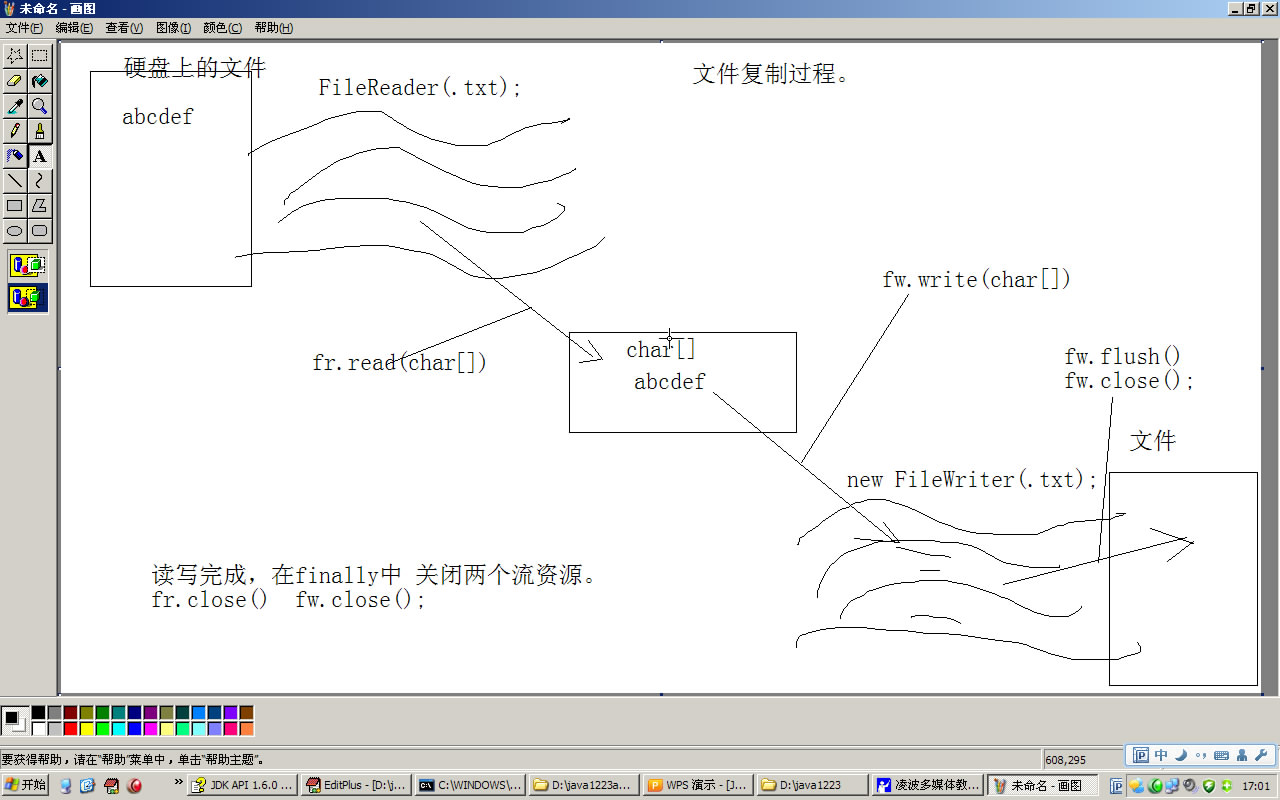/*
Properties。Runtime对象。Date。Calenda。Math。IO流。字符流。
*/
/*
学会自己查阅api方法。
System:类中的方法和属性都是静态的
out:标准输出,默认是控制台
in:标准输入,默认是键盘。
Properties getProperties()
确定当前的系统属性。
*/
import java.util.*;
class SystemDemo
{
public static void main(String[] args)
{
//因为Properties是Hashtable的子类,也就是Map集合的一个子类对象
//那么可以通过map的方法取出该集合中的元素
//该集合中存储的都是字符串,没有泛型定义。
Properties prop = System.getProperties();
Set<String> setName = prop.stringPropertyNames();
for (String name :setName )
{
String value = prop.getProperty(name);
System.out.println(name +".."+value);
}
}
}
import java.util.*;
class System1
{
public static void main(String[] args)
{
//因为Properties是Hashtable的子类,也就是Map集合的一个子类对象
//那么可以通过map的方法取出该集合中的元素
//该集合中存储的都是字符串,没有泛型定义。
Properties prop = System.getProperties();
/*错误的
Set<String> nameSet = prop.stringPropertyNames();//1.6版本才有。
for (String name :nameSet)
{
String value = prop.getProperty(name);
System.out.println(name +".."+value);
}
*/
/*
for (Map.Entry<Object,Object> me:prop.entrySet() )
{
String name =(String) me.getKey();
String value = (String)me.getValue();
System.out.println(name+"::"+value);
}
*/
/*获取所有属性信息
for (Object obj:prop.keySet())
{
String value = (String)prop.get(obj);
System.out.println(obj+"::"+value);
}
*/
//如何在系统中自定义一些特有信息呢?
System.setProperty("mekey","myvalue");
//获取指定属性信息 value:Windows XP,如果没有,返回null
String value = System.getProperty("os.name");
System.out.println("value:"+value);
//可不可以在虚拟机jvm启动时动态加载一些属性信息呢?
String v = System.getProperty("haha");
//java-Dhaha=qqqqq System1
//v = qqqq
}
}
/*
Runtime对象
该类并没有提供构造函数
说明不可以new对象,那么会直接想到该类中的方法是静态的
发现该类中还有非静态方法,
说明该类肯定会提供方法获取本类对象,而且该方法是静态的
并且返回值类型是本类类型。
该方法就是static Runtime getRuntime();
由这个特点可以看出该类使用了单例设计模式
*/
class RuntimeDemo
{
public static void main(String[] args) throws Exception
{
Runtime r = Runtime.getRuntime();
//Process p = r.exec("c:\\winmine.exe");
//r.exec("c:\\winmine.exe");没找到就抛异常。
//r.exec("winmine.exe");如果当前目录没有,会去Path环境变量里找
//Thread.sleep(4000);//为了观看现象
//p.destroy();//杀掉子进程,秒杀。只能杀这个对象进程
Process p = r.exec("notepad.exe SystemDemo.java");
//打开相关文件
}
}
import java.util.*;
import java.util.Date;
import java.text.*;
class DateDemo
{
public static void main(String[] args) throws ParseException
{
/*
Date d = new Date();
System.out.println(d);//打印的时间,希望有些格式
//将模式封装到SimpleDateformat对象中。
SimpleDateFormat sdf = new SimpleDateFormat("yyyy年MM月dd日");
//调用format方法,让模式格式化指定Date对象。
String time = sdf.format(d);
System.out.println(time);
*/
//二个日期之间的天数。
String str1 = "2012-3-17";
String str2 = "2012-4-18";
test(str1,str2);
public static void test(String str1,String str2)throws ParseException
{
DateFormat dateFormat = DateFormat.getDateInstance();
dateFormat = new SimpleDateFormat("yyyy-MM-dd");
Date date1 = dateFormat.parse(str1);
Date date2 = dateFormat.parse(str2);//String格式日期转成日期对象
long time1 = date1.getTime();//2.通过日期对象获取毫秒数
long time2 = date2.getTime();
int date = getDate(time1,time2);
System.out.println(date);
}
public static int getDate(long l1,long l2)
{
long time = Math.abs(l1 - l2);//正数
int date = (int)(time/1000/60/60/24);//3.通过毫秒数得到天数
return date;
}
}
}
import java.util.*;
import java.util.*;
import java.util.Date;
import java.text.*;
class CalendarDemo
{
public static void main(String[] args)
{
/*
Date d = new Date();
System.out.println(d);
SimpleDateFormat sdf = new SimpleDateFormat("yyyy年");
String s = sdf.format(d);
System.out.println(s);
*/
Calendar c = Calendar.getInstance();
String[] month = {"一月","二月","三月","四月",
"五月","六月","七月","八月",
"九月","十月","十一月","十二月",};
//查表法
String[] weeks = {"","星期日","星期一","星期二","星期三",
"星期四","星期五","星期六"};
int index = c.get(Calendar.MONTH);
int index1 = c.get(Calendar.DAY_OF_WEEK);
System.out.println(c.get(Calendar.YEAR)+"年");
//System.out.println((c.get(Calendar.MONTH)+1)+"月");
System.out.println(month[index]);
System.out.println(c.get(Calendar.DAY_OF_MONTH)+"日");
//System.out.println("星期"+c.get(Calendar.DAY_OF_WEEK));
System.out.println(weeks[index1]);
//System.out.println(c.get(Calendar.DAY_OF_WEEK));
}
}
import java.util.*;
/*
练习:
获取任意年的二月有多少天?
思路:根据指定年设置一个时间就是c.set(year,2,1);//某一年的三月一日
c.add(Calendar.DAY_OF_MONTH,-1);3月1日,向前推一天,就是2月的最后一天
2获取昨天的现在的这个时刻?
c.add(Calendar.DAY_OF_MONTH,-1)
*/
class CalendarDemo2
{
public static void main(String[] args)
{
Calendar c = Calendar.getInstance();
//对日历重新设定
//c.set(2012,2,23);//写2代表是3月
//printCalendar(c);
//时间向后推几年add();
//c.add(Calendar.YEAR,4);
//printCalendar(c);
//c.add(Calendar.MONTH,-1);加月
//printCalendar(c);
c.add(Calendar.DAY_OF_MONTH,18);
printCalendar(c);
}
public static void printCalendar(Calendar c)
{//和上面的一样,功能封装
String[] month = {"一月","二月","三月","四月",
"五月","六月","七月","八月",
"九月","十月","十一月","十二月",};
String[] weeks = {"","星期日","星期一","星期二","星期三",
"星期四","星期五","星期六"};
int index = c.get(Calendar.MONTH);
int index1 = c.get(Calendar.DAY_OF_WEEK);
System.out.println(c.get(Calendar.YEAR)+"年");
//System.out.println((c.get(Calendar.MONTH)+1)+"月");
System.out.println(month[index]);
System.out.println(c.get(Calendar.DAY_OF_MONTH)+"日");
//System.out.println("星期"+c.get(Calendar.DAY_OF_WEEK));
System.out.println(weeks[index1]);
}
}
import java.util.*;
class MathDemo
{
public static void main(String[] args)
{
Random r = new Random();
for(int x=0;x<10;x++)
{
//int d =(int)(Math.random()*10+1);//第一次
int d = r.nextInt(10)+1;
sop(d);
}
}
public static void show()
{
double d = Math.ceil(12.34);
//ceil方法特点是:返回大于指定数据的最小整数。(12)返回12.0
double d1 = Math.floor(12.34);
//floor方法特点是:返回小于指定数据的最大整数
long l = Math.round(12.34);//四舍五入
double d2 = Math.pow(2,3);//二的三次方
sop("d="+d);
sop("d1="+d1);
sop("L="+l);
sop("d2="+d2);
}
public static void sop(Object obj)
{
System.out.println(obj);
}
}
/*练习:给定一个小数。保留小数的后二位
先转换成String,再取最后二位,小数点后有几位。
*/
/*
。IO流用来处理设备之间的数据传输
。Java对数据的操作是通过流的方式
。Java用来操作流的对象都在IO包中
。流按流向分为:输入流,输出流
流按操作数据分为两种:字节流和字符流
早期都是用字节流,为什么出现字符流呢?
字节流都能搞定,为了方便处理常见的字符。
字符流对象内部融合编码表。特别是字符转换流的内部融合编码表。
IO常用四个基类:
1.字节流的二个抽象基类:
InputStream,OutputStream
2.字符流的二个抽象基类:
Reader,Writer.
注:由这四个类派生出来的子类名字都是
以其父类名作为子类名的后缀。(前缀名是功能)
如:InputStream的子类FileInputStream
Reader的子类 FileReader.
字符流特点:
IO流是用来操作数据的,
数据的最常见表现形式是:文件。
那么先以操作文件为主来演示
需求:在硬盘上创建一个文件并写入文字数据
找到一个专门用于操作文件的Writer子类对象
FileWriter.以其父类名作为子类名的后缀,前缀名是功能)
没有空构造函数。要操作文件,就要先有文件。
*/
import java.io.*;
class FileWriterDemo
{
public static void main(String[] args) throws IoException
{
//创建一个FileWriter对象,该对象一被初始化,
//就必须要明确被操作的文件。
//而且该文件会被创建到指定的目录下。
// new FileWriter("demo.txt")如果该目录下已有同名文件,将被覆盖。
//其实该步就是明确数据存放的目的地。
FileWriter fw = new FileWriter("demo.txt",true);
// 会抛出异常。new FileWriter("kk:\\demo.txt");
//new FileWriter("demo.txt",true)传入true,不覆盖已有文件。并在末尾处添加。
fw.write("abcde");//调用Write方法,其实写到流里面去了。
//fw.flush();//刷新流对象中的缓冲中的数据,
//将数据刷到目的地中。还可以再写入数据。
fw.close();//关闭前先刷新,不可以再写入,流已经关闭。
}
}
import java.io.*;
/*
IO异常专业的处理方式,
三句都会出异常,当第一句出异常时,
再执行第二句没意义,所以放在一起try
关流动作一定要执行。一般关流要用finally.
在try里面定义的变量,在finally里访问不到。
所以在外面建立引用,在try内初始化,这样fw作用整个函数。
close要单独try,
创建对象不成功呢?fw = new FileWriter("k;\\demo.txt");
所以加上,if(fw!=null)。另外每个流要分别去关。。。
*/
class FileWriterDemo2
{
public static void main(String[] args)
{
FileWriter fw =null;//为了最后的finally里的fw有指向
try
{
fw = new FileWriter("demo.txt");
//传入("demo.txt",true),不覆盖已有文件。并在末尾处添加。
fw.write("abcdefg");//调用Write方法,其实写到流里面去了。+"/r/n"是换行。
}
catch (IOException e)
{
System.out.println(e.toString());
}
finally
{
try
{
if(fw!=null)//创建对象不成功呢?一定要判断
fw.close();
}
catch (IOException e)
{
System.out.println(e.toString());
}
}
}
}
import java.io.*;
class FileReaderDemo
{
public static void main(String[] args) throws IOException
{
FileReader fr = new FileReader("demo.txt");
//创建一个文件读取对象,和指定名称的文件相关联。
//要保证该文件是已经存在的,如果不存在,
//会发生FileNotFoundException
//调用读取流对象的read方法。
//一次读取一个字符,而且会自动向下读.
//int ch1 = fr.read();
/*
System.out.println("ch1="+(char)ch1);
int ch2 = fr.read();
System.out.println("ch2="+(char)ch2);
int ch3= fr.read();
System.out.println("ch3="+(char)ch3);
int ch4 = fr.read();
System.out.println("ch2="+ch4);
*/
int ch = 0;
while((ch=fr.read())!=-1)
{
System.out.println((char)ch);
}
/*
while(true)
{
int ch = fr.read();
if(ch==-1)
{
break;
}
System.out.println((char)ch);
}
*/
fr.close();
}
}
/*
第二种方式,通过字符数组进行读取
Read(char[] ch)
相比之下,第二种方式比第一种好。
第一种,读一个打一下,,
第二种,读一个存一下,存满后再全部一次性打。
*/
import java.io.*;
class FileReaderDemo
{
public static void main(String[] args) throws IOException
{
FileReader fr = new FileReader("demo.txt");
//定义一个字符数组,用于存储读到的字符
//该read(char[]) 返回的是读到的字符个数。重要!!
char[] buf = new char[3];
int num = fr.read(buf);
System.out.println("num="+num+"..."+new String(buf,0,num));
fr.close();
/*
FileReader fr = new FileReader("demo.txt");
char[] buf = new char[1024];
int num = 0;
while((num = fr.read(buf))!=-1)
{
System.out.println(new String(buf,0,num));
}
fr.close();
*/
}
}
/*
将c盘一个文本文件复制到D盘。
复制的原理:
其实就是将C盘下的文件数据存储到D盘的一个文件中。
步骤:
1.在D盘创建一个文件,用于存储C盘文件中的数据
2定义读取流和C盘文件关联
3通过不断的读写完成数据存储
4关闭资源
*/
import java.io.*;
class CopyText
{
public static void main(String[] args) //throws IOException
{
copy_2();
}
//第一种:从C盘读一个字符,就向D盘写一个字符。
public static void copy_1() throws IOException
{
FileReader fr = new FileReader("DateDemo.java");//与已有文件关联
//创建目的地。
FileWriter fw = new FileWriter("demo_copy.txt");//目的地
int num = 0;
while((num = fr.read())!=-1)
{
fw.write(num);//写入,关键,为什么写num?一个一个写
} //num这定义int类型,是为了避免char为-1情况,类型提升,
//write()方法里有自动的类型下降,所以数据还是一样的,后面会讲到。
fr.close();
fw.close();
}
//第二种,先读取,存入缓存,存满再写
public static void copy_2()
{
FileWriter fw = null;
FileReader fr = null;
try
{
fr = new FileReader("IoDemo.java");
fw = new FileWriter("io_copy.txt");
char[] buf = new char[1024];//缓冲区
int len = 0;
while((len=fr.read(buf))!=-1)//这里如何try,分开不好就try全部
{
fw.write(buf,0,len);
}
}
catch (IOException e)
{
//System.out.print("复制失败,创建失败");
throw new RuntimeException("读写失败");
}
finally
{
if(fr!=null)
{
try
{
fr.close();
}
catch (IOException e)
{
System.out.print("关闭失败");
}
}
if(fw!=null)
try
{
fw.close();
}
catch (IOException e)
{
System.out.print("关闭失败");
}
}
}
}
插入图片io流拷贝文本文件图例
























 3万+
3万+

 被折叠的 条评论
为什么被折叠?
被折叠的 条评论
为什么被折叠?








